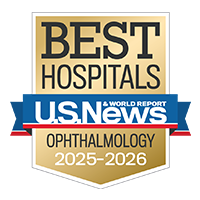X-Linked Retinoschisis

Overview
X-linked retinoschisis (also known as X-linked juvenile retinoschisis) is an inherited eye disorder that occurs almost exclusively in males. Although it begins at birth, the condition is usually not diagnosed until the early school years, when the child has difficulty seeing the blackboard. X-linked retinoschisis is caused by a splitting of the retina (the light-sensitive tissue at the back of the eye), which affects the eye's macula. The macula is part of the retina that is responsible for color perception and central vision, which is needed for detailed tasks such as reading, writing, driving and seeing other fine details clearly. In some cases, peripheral (side) vision is also affected.
Some people with X-linked retinoschisis retain useful vision well into adulthood, while others experience a rapid decline during childhood. In rare cases, the condition can cause serious complications, such as retinal detachment and vitreous hemorrhage, resulting in severely impaired vision or blindness.
Our Approach to X-Linked Retinoschisis
UCSF's ophthalmologists provide comprehensive evaluations and care for all types of eye conditions, from the most common to the rare and complex. They are experts in inherited eye diseases, such as X-linked retinoschisis.
Although X-linked retinoschisis currently has no cure, medication is available that may improve vision. Researchers are working to uncover new treatments, and interested patients may be able to receive experimental therapies by joining a clinical trial. In the rare event that patients develop complications requiring surgery, UCSF has the largest eye surgery program in Northern California.
Low-vision aids, mobility training and other supportive care can also help patients with performing everyday tasks.
Awards & recognition
-

Among the top hospitals in the nation
-

Best in Northern California and No. 10 (tie) in the nation for ophthalmology
Signs & symptoms
A decline in central vision is the hallmark symptom of X-linked retinoschisis. Other symptoms include night blindness, an inability of both eyes to focus on an object (strabismus) and roving, involuntary eye movements (nystagmus). In about half of the cases, peripheral (side) vision is also affected.
Diagnosis
To confirm a diagnosis of X-linked retinoschisis, a test called an electroretinogram is performed, which assesses the function of the retina. A special photograph of the eye called an optical coherence tomogram (OCT) can show the retinal splitting and study the retinal thickness. A visual field test will be performed to evaluate your side vision. In addition, your ophthalmologist may discuss the testing your blood to screen for mutations in the gene that causes X-linked retinoschisis.
Treatments
At this time, there are no cures available for X-linked retinoschisis. However, researchers have identified mutations in a gene on the X chromosome that cause juvenile retinoschisis. They are now studying the gene to determine its function in the retina, with the aim of developing effective treatments for X-linked retinoschisis. Currently, a drug called dorzolamide is available, which as been shown to improve retinal health and restore some vision in people with retinoschisis. Rarely, some patients may develop bleeding in the eye or retinal detachment that may require surgery.
Patients may also benefit from low-vision aids, including electronic, computer-based and optical aids. Orientation and mobility training, adaptive training skills, job placement and income assistance are available through community resources.
UCSF Health medical specialists have reviewed this information. It is for educational purposes only and is not intended to replace the advice of your doctor or other health care provider. We encourage you to discuss any questions or concerns you may have with your provider.









